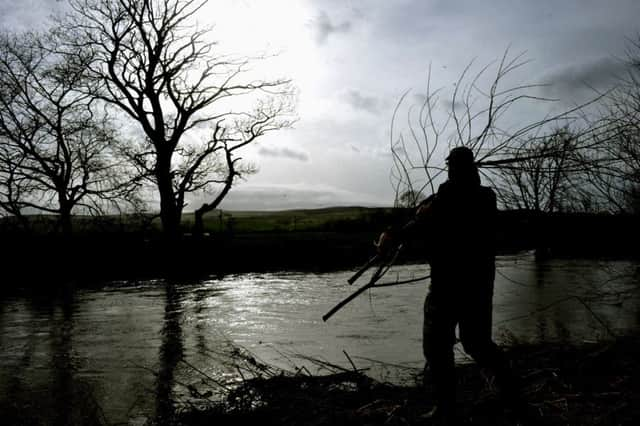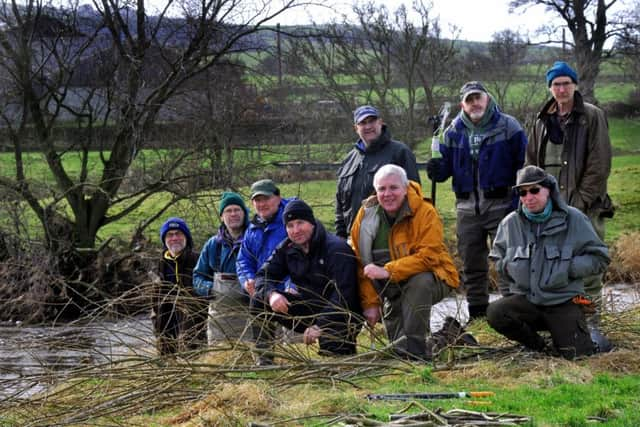The volunteers going with the flow to protect our rivers


The River Aire ran high and coloured and its water looked as thick as treacle. I was walking beside it with Philip Bailey, recently appointed fly fishing secretary of Bradford City Angling Association and Yorkshire import from Australia of 17 years standing.
We were just outside Skipton and a sharp wind stung us. He couldn’t have been further from his climate of birth if he had tried, but presumably he has got used to our Yorkshire ways by now.
Advertisement
Hide AdAdvertisement
Hide AdThe plan was, Bailey was going to show me the work volunteers from the fishing club have been doing to improve the habitat of the river, but unfortunately the water was running so high that it now covered most of it. They had put in deflectors – wooden logs securely staked to the riverbed at an angle to the main flow – to create some variety and use its force to carve out features into this too-uniform channel.


We stood in the open field beside the river, where centuries of livestock farming have left their mark on the landscape by removing most of its features, and the railway that ran by its side had artificially straightened its channel in the building. We lent over one of the newly erected fences and peered into the river as it hurtled past.
“They are down there,” said Bailey awkwardly. “You can see that slight depression in the flow.”
I could – just. At normal levels, these deflectors – and the job they are doing – would be clearly visible. It was just that the day of my visit was the one before Storm Doris was due to hit, and she had given some indication of the ferocity of her intent with heavy rainfall the night before.
Advertisement
Hide AdAdvertisement
Hide AdSo on the day, this eight strong team of volunteers from Bradford City Angling were confined to the bankside, to clearing and planting willow sticks, and their waders remained frustratingly dry.


But the presence of such small groups of volunteers on Yorkshire’s rivers is becoming increasingly common, particularly on the River Aire. They are building on the success of the Upper Aire Project, a multi award-winning river habitat improvement programme which saw organisations such as the Wildlife Trust, Aire Rivers Trust, The Woodlands Trust and the Wild Trout Trust joining forces and putting the volunteer ‘boots on the ground’ which saw 14 km of fencing put up to protect the river from livestock intrusion and 80 ha of woodland planted to provide ground stability and cover.
The project was overseen by the Environment Agency, and its fisheries officer Pete Turner.
“We have been running the Upper Aire project now for five years, and the big thing has been around volunteer involvement,” says Turner. “What we realised very early on is that there are a lot of issues over a very big area and you can’t tackle them all on your own.”
Advertisement
Hide AdAdvertisement
Hide AdThe reason for the growth in volunteering for these sorts of environmental projects is probably due to the confluence of two recent phenomena. One is demographic: the number of baby boomers retiring who are relatively well-off and healthy, and are looking to use their skills and expertise for a worthwhile cause.
The other is the change in thinking about how our rivers should be managed. Opinion is now turning to a more natural philosophy of river management, which is all about slowing down the flow of the river with the strategic placement of in-channel obstacles, managed flooding, and the regeneration of bankside growth.
Many of these are small scale interventions, ones that a fishing club with a handful of volunteers can do on their own stretch of river, for instance, and ones that can cost relatively little in terms of money.
Charities such as the Wild Trout Trust are exploiting this new landscape by visiting and advising fishing clubs and other river owners on work that can be done, and then alongside the Environment Agency, helping them gain any funding that may be needed.
Advertisement
Hide AdAdvertisement
Hide AdThe result is a patchwork of small scale projects which are all beginning to add up to a significant whole, both throughout Yorkshire and nationally.
“The rise of organisations such as the Rivers Trusts and the Wild Trout Trust are making angling clubs more confident in what they do,” says Turner, “which is helping them realise there are simple interventions they can get involved with that improves not only their fishing but the fishery in general.”
And a river which provides good habitat for wild trout is good news for us all, because it means that the river will be playing its part in slowing the flow of water that makes its way down into our towns and cities when the likes of Storm Doris decide to pay a call.
James Munden is now the rather grand sounding President of Bradford City Angling Association and has been involved with the club in some capacity since 1996. Munden is retired from a senior strategic management position and now brings his skills to bear on the club.
Advertisement
Hide AdAdvertisement
Hide Ad“I am a business planner really, and that is what most angling clubs don’t have – a business plan,” he says.
Munden has seen membership of his club reach a low of 900 in 2009, to recover again to 1,300, at which it stands today.
He has been quick to see the ‘bigger picture’ role that angling clubs can play in improving and maintaining the health of our rivers, and welcomed the opportunity for Professor Jonathan Grey of the Wild Trout Trust to join the club’s committee.
“We are beginning to see a change in that in the past, angling clubs have been very much individual organisations,” says Munden. “They have competed against other angling clubs. But there is now a realisation that unless clubs work together, they won’t achieve very much.”
Advertisement
Hide AdAdvertisement
Hide AdMunden told me with some satisfaction that the evening before my visit had seen the first ever meeting of the seven angling clubs on the Aire, discussing how they can work together to improve the river. He is excited by the possibilities such strategic alliances may offer.
“Perhaps, Skipton Angling will come and help us on our work party today, and we will go and help them tomorrow,” he says.